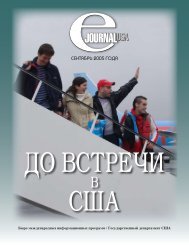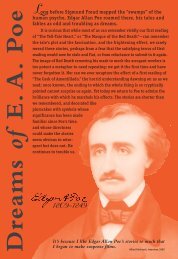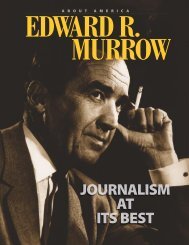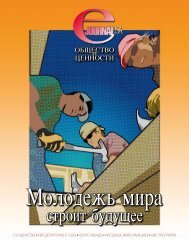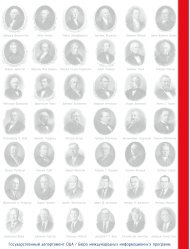AMERICAN
Outline of American Literature
Outline of American Literature
- No tags were found...
You also want an ePaper? Increase the reach of your titles
YUMPU automatically turns print PDFs into web optimized ePapers that Google loves.
pointless wanderings and various<br />
weird enterprises — and his opposite,<br />
the educated Herbert Stencil,<br />
who seeks a mysterious female spy,<br />
V (alternatively Venus, Virgin, Void).<br />
The Crying of Lot 49 (1966), a short<br />
work, deals with a secret system<br />
associated with the U.S. Postal<br />
Service. Gravity’s Rainbow (1973)<br />
takes place during World War II in<br />
London, when rockets were falling<br />
on the city, and concerns a farcical<br />
yet symbolic search for Nazis and<br />
other disguised figures.<br />
In Pynchon’s comic novel<br />
Vineland (l990), set in northern<br />
California, shadowy forces within<br />
federal agencies endanger individuals.<br />
In the novel Mason & Dixon<br />
(1997), partly set in the wilderness<br />
of 1765, two English explorers survey<br />
the line that would come to<br />
divide the North and South in the<br />
United States. Again, Pynchon sees<br />
power wielded unjustly. Dixon asks:<br />
“No matter where…we go, shall we<br />
find all the World Tyrants and<br />
Slaves?” Despite its range, the violence,<br />
comedy, and flair for innovation<br />
in his work inexorably link<br />
Pynchon with the 1960s.<br />
John Barth (1930- )<br />
John Barth, a native of Maryland,<br />
is more interested in how a story is<br />
told than in the story itself, but<br />
where Pynchon deludes the reader<br />
by false trails and possible clues<br />
out of detective novels, Barth<br />
entices his audience into a carnival<br />
fun house full of distorting mirrors<br />
that exaggerate some features<br />
while minimizing others.<br />
“<br />
No matter<br />
where…we go,<br />
shall we find all<br />
the World<br />
Tyrants and<br />
Slaves?” Despite<br />
its range, the<br />
violence,<br />
comedy, and flair<br />
for innovation<br />
in his work<br />
inexorably link<br />
Pynchon with<br />
the 1960s.<br />
Realism is the enemy for Barth,<br />
the author of Lost in the Funhouse<br />
(1968), 14 stories that constantly<br />
refer to the processes of writing<br />
and reading. Barth’s intent is to<br />
alert the reader to the artificial<br />
nature of reading and writing and<br />
to prevent him or her from being<br />
drawn into the story as if it were<br />
real. To explode the illusion of realism,<br />
Barth uses a panoply of reflexive<br />
devices to remind his audience<br />
that they are reading.<br />
Barth’s earlier works, like Saul<br />
Bellow’s, were questioning and<br />
existential, and took up the 1950s<br />
themes of escape and wandering.<br />
In The Floating Opera (1956), a<br />
man considers suicide. The End of<br />
the Road (1958) concerns a complex<br />
love affair. Works of the 1960s<br />
became more comical and less<br />
realistic. The Sot-Weed Factor<br />
(1960) parodies an 18th-century<br />
picaresque style, while Giles Goat-<br />
Boy (1966) is a parody of the world<br />
seen as a university.<br />
Chimera (1972) retells tales<br />
from Greek mythology, and Letters<br />
(1979) uses Barth himself as a<br />
character, as Norman Mailer does<br />
in The Armies of the Night. In<br />
Sabbatical: A Romance (1982),<br />
Barth uses the popular fiction<br />
motif of the spy; this is the story of<br />
a woman college professor and her<br />
husband, a retired secret agent<br />
turned novelist. Later novels —<br />
The Tidewater Tales (1987), The<br />
Last Voyage of Somebody the Sailor<br />
(1991), and Once Upon a Time: A<br />
Floating Opera (1994) reveal<br />
Barth’s “passionate virtuosity” (his<br />
109




